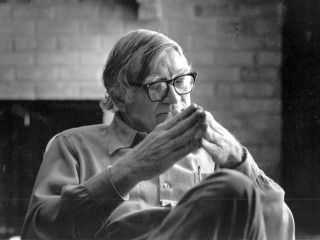
Dee Brown (author) biography
Date of birth : 1908-02-28
Date of death : 2002-12-12
Birthplace : Alberta, Louisiana, U.S.A
Nationality : American
Category : Famous Figures
Last modified : 2011-09-14
Credited as : novelist, historian, Bury My Heart at Wounded Knee
3 votes so far
When Brown was five years old, his father died, forcing his mother to move to Ouachita County, Arkansas, where her family lived. While his mother worked days at a local store, Brown's grandmother took care of him. Her father had known the legendary frontiersman and politician Davy Crocket, and she told the stories she knew about him as well as ones from the Civil War.
Like many children of his generation, Brown spent a lot of time at the movies, enjoying films that portrayed cowboys as heroes of the West, conquering the savage Indians. Brown had friends who were Native American and they explained to him that the Indians on the big screen did not represent real Indians. His social consciousness raised, Brown went on to found his own tabloid at the age of 15. He and his cousin bought a hand press with which they published editorials attacking local entities like the oil companies for environmental degradation.
After high school, Brown worked as a reporter and printer for the newspaper in Harrison, Arkansas. From there he went on to Arkansas State Teachers College, where he studied history and worked in the library. After graduation he was faced with the Depression and floated from job to job, eventually ending up in Washington, D.C. He worked at the U.S. Department of Agriculture's library until he was drafted by the Army. During the Depression, Brown married Sara Baird Stroud; they had two children.
Brown would work at the library, and after his children went to bed, he would write. He placed third in a short story contest and attracted the attention of literary agents. He was commissioned to write a satirical book about bureaucracy in the federal government. By the time Brown finished the book, public sentiment about the government had changed due to the war in Europe. A satire would not be so easily accepted in those patriotic times. The book was cancelled. Instead, Brown published a novel he wrote in two months called Wave the Banner High, about Davy Crockett.
In 1942, Brown was drafted into the Army. For most of World War II, he worked as a librarian at the Aberdeen Proving Ground. After the war was over, Brown collaborated with Martin F. Schmitt on three books. From 1948 to 1955, they published Fighting Indians of the West, Trail Driving Days, and The Settlers' West. The book were created using photographs from the National Archives compiled by Schmitt and commentary provided by Brown.
Throughout the '50s and '60s, Brown continued to write while working as a librarian at the agriculture library for the University of Illinois at Champaign Urbana. During that time he earned his master's degree in library science. His focus was almost exclusively on the history of the West, but he always approached the topic from a perspective that was different from what was traditionally taught or portrayed. This approach was not always welcomed. Further research was blocked by the railroad companies once they learned that Brown's book, Hear That Lonesome Whistle Blow, was highly critical of the exploitive practices of the railroad companies. Other nonfiction books written in this vein were Gentle Tamers: Women of the Old Wild West and Grierson's Raid: A Cavalry Adventure of the Civil War.
In 1970, Brown's most influential book was published. Years of research, compiling speeches and documentation plus two years of writing, produced the almost 500page chronicle of Native American reaction to the settlement of whites into their territories. Bury My Heart at Wounded Knee: An Indian
History of the American West was a bestseller. Since its publication it has sold more than five million copies and been translated into 15 languages.
Bury My Heart at Wounded Knee focused on the mis-treatment that Native Americans suffered between 1860 and 1890. Racist practices, lies, deception, and carelessness were highlighted. The book added another dimension to the historical perception of the American frontier. It changed scholarly attitudes toward the West. Finally, it engaged a generation of Native Americans. University of Arkansas at Little Rock professor C. Fred Williams told Elaine Woo of the Los Angeles Times, "The effect of Bury My Heart was essentially to give voice to the American Indians. They were always an important part of the American West, usually as the indirect object. Dee Brown [made] them the direct object."
Brown retired from his position as librarian and professor at University of Illinois in 1972 and returned to Arkansas. He continued writing, publishing his last book, The Way to a Bright Star, in 1998. He contributed to many anthologies and collections, including Growing Up Western, Dee Brown's Civil War Anthology, and Dee Brown's Folktales of the Native Americans, Retold For Our Times.
Brown's wife died in 2001. He died on December 12, 2002, at the age of 94 from congenital heart failure. He is survived by his son, daughter, sister, and a grandson. Brown wrote many historically valuable books, but Bury My Heart at Wounded Knee had an invaluable and extensive impact on how Native American history is viewed.
















